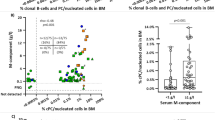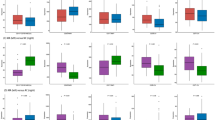Abstract
During the last two decades, major progress has been made in the technology of flow cytometry and in the availability of a large series of monoclonal antibodies against surface membrane and intracellular antigens. Flow cytometric immunophenotyping has become a diagnostic tool for the analysis of normal and malignant leukocytes and it has proven to be a reliable approach for the investigation of minimal residual disease (MRD) in leukemia patients during and after treatment. In order to standardize the flow cytometric detection of MRD in acute leukemia, a BIOMED-1 Concerted Action was initiated with the participation of six laboratories in five different European countries. This European co-operative study included the immunophenotypic characterization and enumeration of different precursor and mature B cell subpopulations in normal bone marrow (BM). The phenotypic profiles in normal B cell differentiation may form a frame of reference for the identification of aberrant phenotypes of precursor-B cell acute lymphoblastic leukemias (precursor-B-ALL) and may therefore be helpful in MRD detection. Thirty-eight normal BM samples were anal- yzed with five different pre-selected monoclonal antibody combinations: CD10/CD20/CD19, CD34/CD38/CD19, CD34/ CD22/CD19, CD19/CD34/CD45 and TdT/CD10/CD19. Two CD19− immature subpopulations which coexpressed B cell-associated antigens were identified: CD34+/CD22+/CD19− and TdT+/CD10+/CD19−, which represented 0.11 ± 0.09% and 0.04 ± 0.05% of the total BM nucleated cells, respectively. These immunophenotypes may correspond to the earliest stages of B cell differentiation. In addition to these minor subpopulations, three major CD19+ B cell subpop- ulations were identified, representing three consecutive maturation stages; CD19dim/CD34+/TdT+/CD10bright/CD22dim/ CD45dim/CD38bright/CD20− (subpopulation 1), CD19+/CD34−/ TdT−/CD10+/CD22dim/CD45+/CD38bright/CD20dim (subpopulation 2) and CD19+/CD34−/TdT−/CD10−/CD22bright/CD45bright/CD38dim/ CD20bright (subpopulation 3). The relative sizes of subpopulations 1 and 2 were found to be age related: at the age of 15 years, the phenotypic precursor-B cell profile in BM changed from the childhood 'immature' profile (large subpopulations 1 and 2/small subpopulation 3) to the adult 'mature' profile (small subpopulation 1 and 2/large subpopulation 3). When the immunophenotypically defined precursor-B cell subpopulations from normal BM samples are projected in fluorescence dot-plots, templates for the normal B cell differentiation pathways can be defined and so-called 'empty spaces' where no cell populations are located become evident. This allows discrimination between normal and malignant precursor-B cells and can therefore be used for MRD detection.
This is a preview of subscription content, access via your institution
Access options
Subscribe to this journal
Receive 12 print issues and online access
$259.00 per year
only $21.58 per issue
Buy this article
- Purchase on Springer Link
- Instant access to full article PDF
Prices may be subject to local taxes which are calculated during checkout
Similar content being viewed by others
Author information
Authors and Affiliations
Rights and permissions
About this article
Cite this article
Lúcio, P., Parreira, A., van den Beemd, M. et al. Flow cytometric analysis of normal B cell differentiation: a frame of reference for the detection of minimal residual disease in precursor-B-ALL. Leukemia 13, 419–427 (1999). https://doi.org/10.1038/sj.leu.2401279
Received:
Accepted:
Published:
Issue Date:
DOI: https://doi.org/10.1038/sj.leu.2401279
Keywords
This article is cited by
-
Analytical Appraisal of Hematogones in B-ALL MRD Assessment Using Multidimensional Dot-Plots by Multiparametric Flow Cytometry: A Critical Review and Update
Indian Journal of Hematology and Blood Transfusion (2024)
-
Have we been qualifying measurable residual disease correctly?
Leukemia (2023)
-
Bone Marrow Grafts From Pediatric Donors May Contain A Considerable Number of Hematogones
Indian Journal of Hematology and Blood Transfusion (2022)
-
Monitoring minimal/measurable residual disease in B-cell acute lymphoblastic leukemia by flow cytometry during targeted therapy
International Journal of Hematology (2021)
-
Clinical impact of hematogones on outcomes of allogeneic hematopoietic stem cell transplantation
Annals of Hematology (2015)



